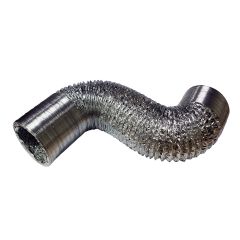Aluminum ducting, particularly aluminum flexible ducting, is commonly used in HVAC (Heating, Ventilation, and Air Conditioning) systems for residential and commercial applications. It offers several advantages that make it a popular choice for ducting.
Lightweight and Flexible: Aluminum ducting is lightweight and easy to maneuver, making installation simpler compared to rigid duct materials. Its flexibility allows it to be easily routed around obstacles and tight spaces.
Corrosion Resistance: Aluminum is naturally resistant to corrosion and rust, making it suitable for use in damp or humid environments, such as bathrooms and kitchens. This resistance helps maintain the integrity of the ducting over time.
Heat Resistance: Aluminum can withstand high level temperatures without deteriorating or emitting harmful fumes, making it a safe option for venting or exhausting.
Smooth Interior Surface: Aluminum ducting typically has a smooth interior surface, which helps reduce air friction and turbulence as air flows through the ducts. This contributes to efficient airflow and helps minimize energy losses.
Airtightness: When properly installed and sealed, aluminum ducting can provide an airtight pathway for air to flow. This is important for maintaining the efficiency of HVAC systems and preventing air leaks, which can lead to energy wastage.
Easy Maintenance: Aluminum ducting is relatively easy to clean and maintain. Its smooth surface prevents debris buildup, and it can be cleaned using a brush or vacuum.
Cost-Effective: Aluminum ducting is generally more affordable than some alternative materials, such as stainless steel or insulated flexible ducting. This makes it a cost-effective choice for both residential and commercial installations.






















